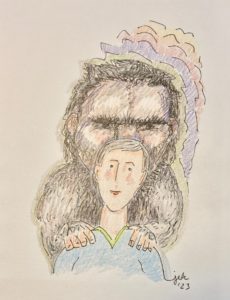
-Illustration © 2023 Jan
Ever-present in the background of ego consciousness is the archetypal human, that which, with its accumulated wisdom from having lived the entirety of human history, lives inside us and reacts along with us as we think, imagine, and encounter the phenomenal world.
Imagine standing at the edge of a tall mountain, flying in a plane, or crossing a turbulent river. The immediate instinctual reaction of our inner archetypal human might be anxiety, as it accents its knowing of potential danger. Archetypal triggers are the emotional downloads of ancient wisdom, gleaned from prior human experience, that automatically react to similar stimuli that appear in present-day life.
Our ego reaction to these same imaginary scenes might be to quickly rationalize the overwhelming statistics of the safety of flying and the ability to stay calm and in control in challenging situations. These efforts are attempts to minimize archetypal fears and master the challenges presented.
Ultimately, ego is tasked with becoming the Hero, who finds the means to surmount the archetypal challenges being presented. Ego does well to begin with humility. Instinctual reactions are automatic; there is no blame in the reaction of terror.
The thought of giving a speech or performing before an audience might provoke immediate terror. It’s a completely valid instinctive response. This is the archetypal mind scanning the power of groups in myriads of human encounters throughout history and delivering its verdict—terror.
The lowered consciousness of group mind in such experiences has resulted in many tragic consequences in the course of human history. The ego does well to acknowledge this truth and to consider how it might best prepare itself for such a challenging event.
Sometimes ego might attempt to puff itself up to feel equal to or greater than the power of the archetypal trigger. Positive self-talk in such circumstances may be helpful but is not likely to maintain the confidence needed for true mastery.
The Hero’s journey is its own archetypal journey of ego development. First and foremost, one must heed the call to action. The call originates from our High Self or Spirit, informing us that it is time to grow: “Yes, you must meet with this person whom you experience as the archetypal bully or harpy.”
The instinctive reaction to freeze or retreat is respected but not chosen for this challenge to be successfully met. One might engage in yoga, breath work, meditation, neurofeedback, or any body-centered technique to increase conscious control over the instinctual reactions of the central nervous system generated by the archetypal mind.
The home of the archetypal human is the subconscious mind, which responds immediately to triggers or suggestions by generating chemical and electrical reactions in the body. The use of conscious positive suggestions to the body present new behavioral options to the subconscious mind. Just as the subconscious mind reacts to instinct, it also reacts to consciously generated suggestions.
Thus, regular self-hypnosis that suggests actions of calm and mastery can give the ego greater control over the habitual, instinctive reactions of the archetypal mind. The calmer we can be in an archetypal encounter the greater will be our ability to remain present and to respond quickly and thoughtfully to rapidly changing conditions.
Practice, practice, practice! This is the guidance given to all music students. Its wisdom can be generalized to prepare all of us for all kinds of archetypal encounters.
For instance, visualizing the scene and the myriad of possible permutations of an event, accompanied by the bilateral recapitulation breath as you live those scenes, allows you to gain greater clarity, fluidity and calm over the actual event.
Ego is also free to ask for help and support from its High Self, who appreciates ego’s efforts to meet its appointed task. In particular, one might ask the High Self for help in gaining access to the appropriate words and ideas that would be helpful as it navigates the challenge before it. Memorization has its place, but a quickness of mind is best suited to be fully present and responsive to an unfolding challenge.
Ultimately, the archetypal human is extremely conservative. Its aim is to keep us safe and alive. In fact, in actual life-threatening circumstances this ancient human can take possession of the ego and the body and perform superhuman feats. Don’t leave home without your archetypal human self!
On the other hand, realize that consciousness was evolved at the behest of the archetypal mind, who saw the wisdom of being able to change course on a dime, rather than suffer the consequences of habitual patterns ill-fitted to changing circumstances.
The ego is the child of the archetypal human who must truly become the adult to the personality, working respectfully with its archetypal partner and cohort.
Archetypal triggers are merely necessary tests meant to be mastered. Also, life always provides many makeup tests!
Choose wisely,
Chuck


